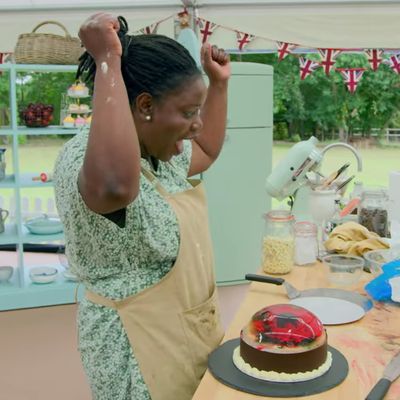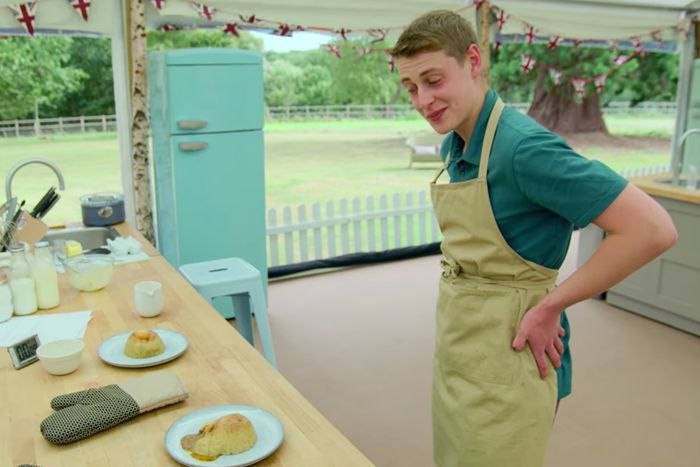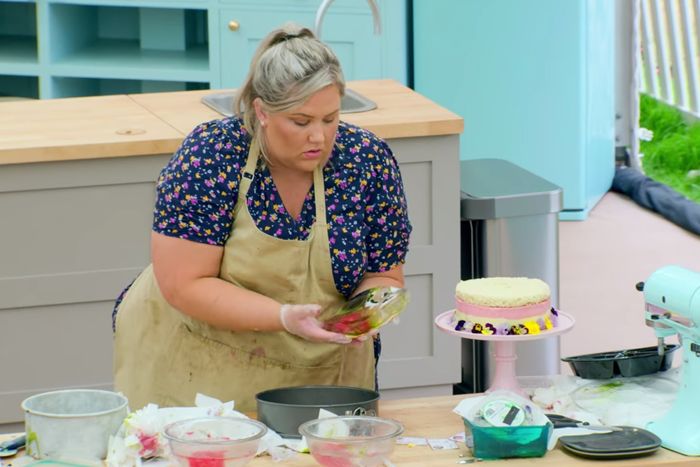
Let us start with the Sussex pond pudding, the great excitement of our annual dessert week episode of Great British Bake Off. “What is Sussex pond pudding?” you may be thinking, to which I say: exactly. This is the Bake Off I have craved; perhaps it has been here the whole time, buried beneath a pile of rainbow bagels.
Sussex pond pudding is a 17th-century dessert based on suet pastry, which you make by combining flour with the hard fat surrounding the inner organs of cows and sheep, wrapping that around a whole lemon, and then steaming it into a golden lump that oozes caramelized lemon-butter juice when you cut into it. Like a pond! “It’s sort of surprising,” reflects Prue contemplatively, “because there’s a whole lemon inside.” It is an act of pastry and an act of patriotism. “Puddings like this go back so far in British history,” says Paul. “Steamed puddings are what we were known for.” His eyes, they are so blue.
Nobody knows how to make Sussex pond pudding, presumably because of the passage of time, and so you could argue that this week’s Technical Challenge is yet another gimmick, that it is too obscure, that whether a present-day home baker knows how long to steam their suet pud tells you nothing about how well they can or cannot bake.
This might be true. I do not care. This is the Great British Bake Off, and it is Greatest when it is Britishist, a fantasy English idyll where woodland creatures frolic and the only jobs are sheepherding and solving wholesome murders; of course they’re making Sussex pond pudding, that is how it should be. “The Sussex pond pudding is British stodge at its very best” — I read that in the Guardian!
Great British Bake Off is a show that cares about appearances (though never, to its credit, at the expense of flavor). It likes its bakes neat and its layers well-defined and its cake-busts lifelike. But Sussex pond pudding is not attractive. It defies the laws of Instagram. Before you cut into it, it is, at best, a rustic brown dough-mound, and after, it’s an oozing brown butter swamp. This is true escapism. When else are we allowed to aspire to this kind of boggy mess? It is the anti-kawaii cake. That you’re then supposed to douse it in crème anglaise only makes it swampier, brown on brown on cream on brown, swirling together in a puddle with a depressed whole lemon in it. And it is Prue’s favorite pudding of them all!
“Does anybody even eat this in 2020?” laments Hermine, who clearly has not been keeping up with the Guardian’s pudding coverage.
Everybody fails, but they are very British failures. Dave didn’t seal his correctly, so his is less a pond than an ocean with some pastry islands floating in it. Hermine’s pastry is almost nice, but her undercooked lemon is “bullet hard.” Peter’s collapsed rendition might have been delicious had he cooked it for another hour, and Marc’s is likewise understeamed. Laura’s wasn’t good either, but it has the singular honor of being the least bad, so she wins, and then Matt Lucas reminds everyone they’re still supposed to clap. This is what they mean, I think, when they talk about an empire in decline.
It is, if not the ideal challenge, then the ideal challenge for my mood. Take me to a British lemon bog, I say! Make me a preindustrial mutton-fat pudding with an entire rindy lemon in the middle of it! I already live in the reality of rainbow Insta-bagels, and it is stressful and exhausting and nobody is totally sure if the current president will vacate office and all I want is to watch British bakers earnestly attempt to steam some 17th-century puds.
The rest of the episode is equally gentle, if slightly less British, on account of how you can only make Sussex pond pudding once. For the Signature, the remaining five bakers attempt 12 minicheesecakes, mostly made with passionfruit. “They are to be very exquisite,” Prue explains, insightfully. They are universally fine. Peter’s collapses slightly in the middle, and Marc’s spreads too much. Paul thinks Dave might be using too much gelatin in his topping, but then it turns out he’s wrong, and it’s actually the perfect amount of gelatin, and there are no problems. This is the drama I live for.
And it is, it turns out, a harbinger of gelatins to come, because for the dessert Showstopper, everyone is making a “Jelly Art Design Cake,” which is a regular cake with a high-concept layer of interpretive gelatin on top of it. Apparently, sculptural jelly art cakes were invented in Mexico City in 1993, which is a fact I learned on the Facebook page of a company that offers 3-D jelly art classes in Singapore. In this literal sense, it is distinctly not British, but it is spiritually very Bake Off, meaning that it is unfathomably complicated but everyone approaches it as though it is a totally normal request unworthy of further comment, tut-tut, cheerio, make a jelly art cake.
More staggering: The jelly art cakes are all beautiful. I would like to explain now how to make a jelly art cake, but I have watched the sequence several times and I still don’t know. What you do is set a clear jelly dome and then methodically inject other jelly, thus creating “jelly art.” It seems to involve surgical tools. Marc, for example, makes two tiers of apple jelly injected with a rose and jasmine garden. Peter makes a jelly Christmas snow globe with panna cotta reindeer in it, and Laura is making a gelatin rendition of her home koi pond, complete with “moulded jelly koi carp” atop a Génoise sponge. Dave, meanwhile, is free-handing a gelatinous Newquay beach scene, which will sit on a chocolate fudge cake with clotted cream mousse, and Hermine is doing a chocolate and strawberry mousse cake finished with a giant jelly dome encasing a single, perfect jelly poppy.
“We have a wibble-wobble!” exclaims Marc. “Jeepers creepers!” replies Peter. In the brush, a sparrow chirps.
Every cake is stunning, and four out of the five are also attractive. Laura’s koi cake is “perfect, actually,” and Dave’s aspirational surf cake is “astonishing,” even if his clotted cream mousse is stodgy. Peter’s giant pink and neon-green Christmas extravaganza is slightly unsettling — if we’re being honest, it’s more of a trifle than a cake — but apparently it is beautiful in flavor, while Marc’s double-decker floral arrangement cannot compensate for the curdled concrete that is his cake. It is the opposite of Hermine’s enormous poppy, which is “absolutely gorgeous” in all possible ways. As a cake and as a flower, it is a triumph. For the second week in a row, she is star baker; for the first week, and his last week, Marc is banished back to Cornwall. “I think Marc was a real gent,” reflects Laura, tearfully, against the backdrop of the rolling British hills.






